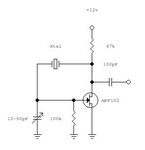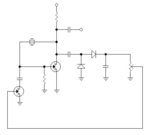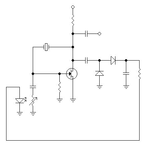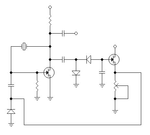neazoi
Advanced Member level 6
Hello,
I have made this oscillator and it outputs a low distortion sinewave at all HF feqencies (1M oscilloscope).
The "problem" is that the variable capacitor has to be adjusted if the crystal is changed, for a clean sinewave (or constant signal level) at the output, because of the different characteristics of different crystals and when different frequencies are needed.
I would like to hear your proposals on how to somehow make this capacitance auto adjusted, so that the output level remains constant with different crystals/frequencies.
A thought I had, was to somehow detect the output signal level. If it is lower than a preset threshold, then I perform an action to adjust the capacitor accordingly.
Any thoughts will be appreciaded, but keep in mind that the solution has to be kept simple.
I have made this oscillator and it outputs a low distortion sinewave at all HF feqencies (1M oscilloscope).
The "problem" is that the variable capacitor has to be adjusted if the crystal is changed, for a clean sinewave (or constant signal level) at the output, because of the different characteristics of different crystals and when different frequencies are needed.
I would like to hear your proposals on how to somehow make this capacitance auto adjusted, so that the output level remains constant with different crystals/frequencies.
A thought I had, was to somehow detect the output signal level. If it is lower than a preset threshold, then I perform an action to adjust the capacitor accordingly.
Any thoughts will be appreciaded, but keep in mind that the solution has to be kept simple.



